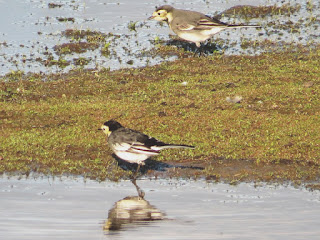The light was amazing and the local Kingfisher was up for posing on the perch placed in front of the main public hide, albeit at some distance. I make no apologies for majoring on this individual. It is not always appreciated that only the back of Kingfishers is electric blue and head-on it is brick red. Note the black ‘toe nails’.
Stunning! And with a fish in its bill too.
I am out of superlatives.
Of course it wasn’t on its perch to pose for photographs. It was looking for fish and when spotted off it went.
Not have a ‘professional’ camera means I could not ‘freeze’ the final plunge. But you get the idea.
Back on its perch complete with fish.
And ‘down the hatch’.
Back to work. Willing a fish to appear.
Seemed to work. Here it comes back with a another catch. While I was watching every dive caught a fish.
Sitting in the vegetation hardly makes it well camouflaged.
This IS a duck Shoveler and a neck-breaking bird it is too. Note the green leg.
Two Greylag Geese leave.
And another four leaving.
Five Common Teal, three of them splendid drakes doing a bit of competitive display.
A drake in close-up.
And a pair.
A Lapwing in great light.
The green sheen in the plumage depends upon the angle of light.
A size comparison between Lapwing and a pair of Common Teal.
A pair of Pied Wagtails – the male with the blacker plumage.
The reflective male.
A ‘grab shot’ of a Redwing in the shade. The white eye-brow is the main clue here.
A typical ‘angry bird’ Goldfinch tucks in to the Teasel heads.
Presumably they are too light to feel the sharp points as they stand on the Teasel heads.”
(Ed Wilson)





























